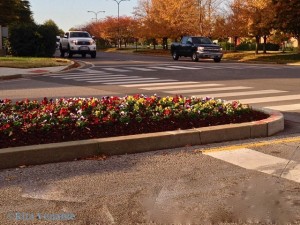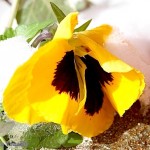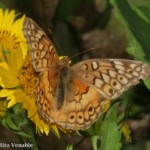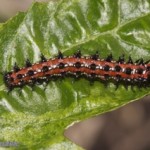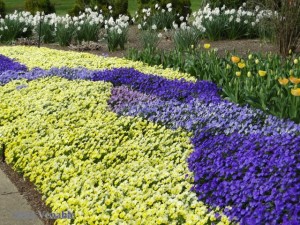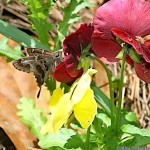In the fall, pansies are almost everywhere: in road median plantings, in front of apartment complexes and businesses, and in porch pots. Even fast-food places have pansy-laden entrances. What is it about pansies that make them so popular?
There are several reasons for their popularity. They are available in many nurseries, are relatively inexpensive, and are practically carefree. They are available in pink, yellow, purple, red, blue, yellow, or white. Many of them have interesting dark “faces.”
Landscapers and gardeners alike use vibrant pansies in landscape borders, garden beds, containers, rock gardens, hanging planters, and as groundcovers. They are used in fall mantelpiece arrangements and as fillers in flower arrangements. Some people give pots of pansies as holiday gifts.
Pansies are in the violet family (Violaceae) and were first cultivated in Europe from wild violets. By 1833 there were over four hundred named pansies available to gardeners. According to Wildflowers of Tennessee, the modern garden pansy (V. x wittrockiana) is a plant of complex hybrid origin involving at least three species of pansy.
Variegated Fritillary caterpillars feed on pansies and they may still be around even in November in Tennessee. Both the Long-tailed Skipper and the Zabulon Skipper nectar on pansies. Not all pansies, however, make good nectaring plants.
In Tennessee, pansies may be planted in either spring or fall. You can plant seeds indoors in late winter and transplant them to the garden in the spring or spread seeds outside in summer for the following year. If you plant pansies in the fall, they may last through a mild winter and bloom again in spring. If you plant them in the spring, some may survive our hot summers here and bloom again in fall. They grow about 4-12 inches tall and grow best in rich, moist, well-drained soil, in full sun to part shade.
Fortunately, pansies are not invasive (although it seems like they would be) and do not spread endlessly in your yard and in natural areas.
The downside of planting pansies in your landscape is that they are so practical that many people plant them, so they are becoming overused. As Elizabeth Farrar writes:
…it is perfectly possible to have too much of a good thing, and the ubiquitous garden pansy seems to be in danger of aping the florists’ chrysanthemum. Now available twelve months out of twelve, they could soon acquire a reputation as the second most boring flower of the decade.
Not true for the butterfly gardener. There is a place for pansies in the butterfly garden when one considers their usefulness as hostplants for the Variegated Fritillary, a common garden butterfly. There must be some pansy varieties out there that are good nectaring plants as well, and they are worth searching for.
©Rita Venable 2013
References
Bradley, Fern Marshall and Barbara W. Ellis. Rodale’s All-New Encyclopedia of Organic Gardening. Rodale Press, Emmaus, PA. 1997.
Coffey, Timothy. The History and Folklore of North American Wildflowers. Houghton Mifflin Co. 1993.
Damrosch, Barbara. Theme Gardens. A Regina Ryan Book. Workman Publishing, New York. 1982.
Ellis, Barbara, editor. Rodale’s Illustrated Encyclopedia of Gardening and Landscaping Techniques. Rodale Press, Emmaus, PA. 1990.
Elpel, Thomas. Botany in a Day. HOPS Press, LLC. Pony, Montana. 2nd Printing, 5th edition, May 2006.
Farrar, Elizabeth. “On the Subject of Pansies, Violas and Violettas.” Written in 2000. The American Violet Society website. http://www.americanvioletsociety.org/Species_N_Cultivars/Pansy.htm
Hessayon, Dr. D. G. The Container Expert. Expert Books. New York. 2000.
Horn, Dennis and Tavia Cathcart. Wildflowers of Tennessee, the Ohio Valley, and the Southern Appalachians. Lone Pine Publishing. 2005. 1st edition.
Packer, Jane. The Complete Guide to Flower Arranging. DK Publishing, Inc. 1995, 1998.
Stokes, Donald and Lillian. A Guide To Enjoying Wildflowers. Stokes Nature Guides. 1985.
